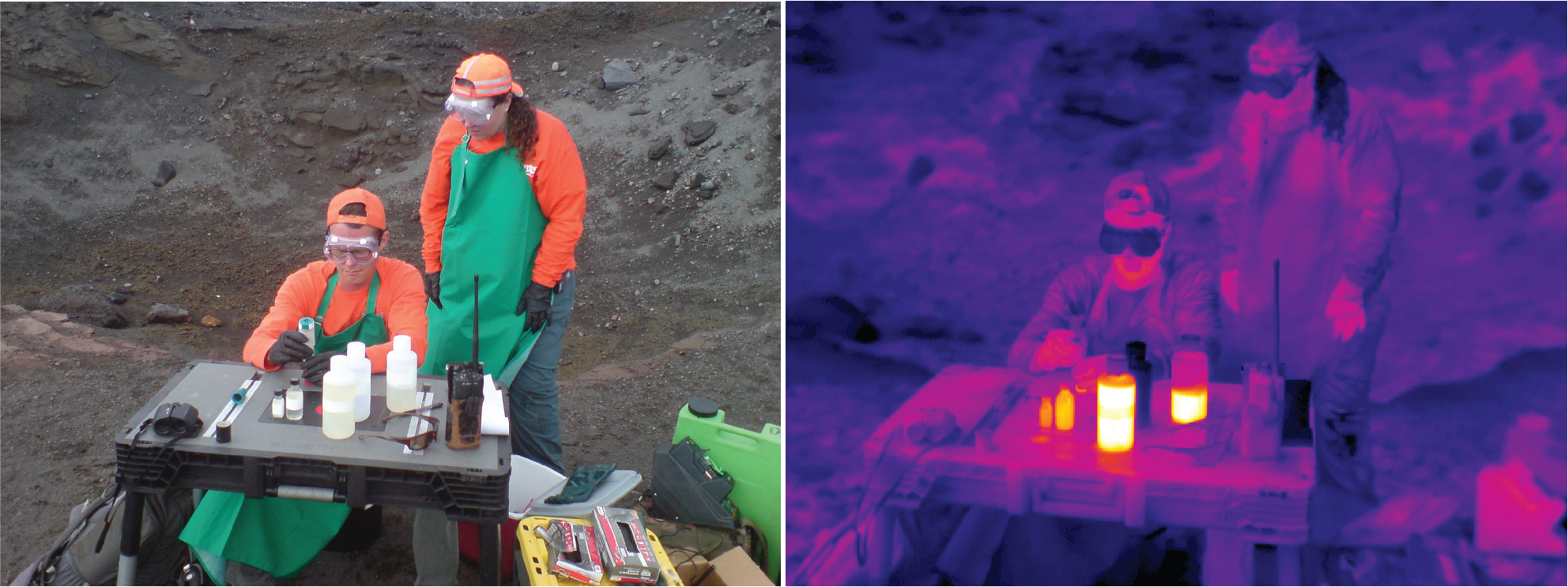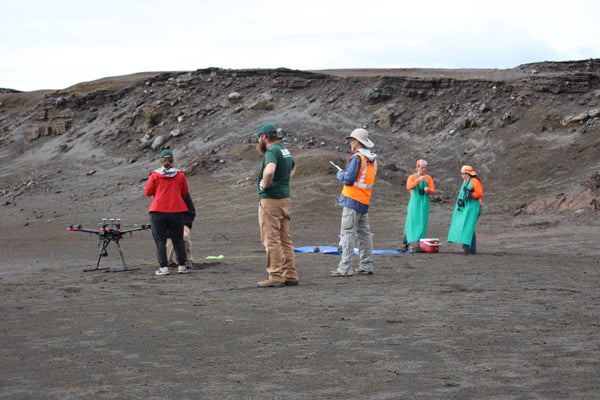This article was published in Scientific American’s former blog network and reflects the views of the author, not necessarily those of Scientific American
Kilauea isn’t currently erupting, but that doesn’t mean the volcano has stopped giving geologists at the Hawaiian Volcano Observatory plenty to do! There’s still all of the monitoring necessary on an active volcano – Kilauea could recharge its magma chamber and get back to the lava shows very soon. There’s plenty of research to be conducted in and around the newest bits of the Big Island, plus lots of data left to crunch from last year’s eruption. And there’s a bouncing baby crater lake to investigate! That lake is what’s capturing our attention today.
On October 26th, 2019, HVO and Hawai’i Volcanoes National Park staff coordinated the first hexicopter (UAS) flight down to the lake to collect a water sample. They used the drone to lower a sterilized plastic sleeve into the acidic yellow-green waters and draw up 750 milliliters (25 ounces) of water for testing. It was an exciting and important moment: our first “taste” of the world’s newest crater lake.
Direct sampling of the water has been a goal of HVO since the lake was first discovered back in July; the chemical composition of the water couldn’t be measured remotely, and it holds important clues to the origin of the lake. It also could reveal important information about the volcanic gasses being emitted at Kilauea’s summit crater, and give us clues about any hazards that are rising in Pele’s restless home.
On supporting science journalism
If you're enjoying this article, consider supporting our award-winning journalism by subscribing. By purchasing a subscription you are helping to ensure the future of impactful stories about the discoveries and ideas shaping our world today.
Preliminary tests conducted immediately after the drone returned the sample revealed the waters have a pH of 4.2, roughly the same level of acidity as many of the fruit juices you can find on grocery store shelves. Scientists also found high concentrations of magnesium and sulfur. The sample was then sent to a USGS lab on the US mainland for more detailed testing. The lab confirmed the 4.2 pH, which places this crater lake in a rather uncommon spot:
Interestingly, most volcanic crater lakes have a pH of less than 3.5 (more acidic) or higher than 5 (less acidic), which places the Halema‘uma‘u lake's pH squarely in the uncommon middle range. However, that might result from the lake's young age and ongoing growth.
It could be youth and vigorous growth causing the oddity. More research and analysis will be needed to discover just why this water sits in the lonely middle.
Why is the water acidic? It contains high concentration of sulfate ions, roughly 50,000 milligrams per liter.This isn’t surprising: sulfur dioxide dissolves easily in water, and there’s plenty of SO2 gas in Halemau’uma’u crater, where the majority of the SO2 from Kilauea’s magmatic system outgasses. Currently, HVO is measuring a modest 30 tonnes of SO2 per day, but that’s not taking into account the gas being absorbed by the crater lake. We’ll need more samples to be sure, but the amount of SO2 in the water could put emissions as high as 200 tonnes per day, the same rate detected before the summit lava lake appeared in 2008. It will be critical to keep a close eye on the amount of SO2 being dissolved in the water in order to help determine whether magma is rising again.
If there’s so much dissolved SO2 , and SO2 makes water acidic, why doesn’t the crater lake have a lower pH?
…acidic water reacts chemically with Kīlauea's basaltic rock, which makes the lake less acidic (raises the pH) and results in high concentrations of magnesium in the water. (Basalt is classified as a mafic rock due to its large amount of magnesium and iron [Mg and Fe] in addition to other elements, such as sodium and potassium.)
So we know the water and the basalt are reacting with one another. We have confirmation of that in the magnesium to sodium and sodium to potassium rations the lab found, which match the ratios found in Kilauea’s basalt rocks.
Dissolved calcium in the water is “combining with sulfate ions to form solid minerals that precipitate from the water.” Other chemical reactions with iron ions are also busy forming new minerals, and could be responsible for the intriguing colors of the water. The lake is a veritable volcanic chemistry set! I’d dearly love to get a look at that lake bed; there must be a fascinating blanket of minerals coating it.
Further testing of the oxygen and hydrogen molecules forming the lake water show it originated as rain, which fell and soaked into the porous basalt to form groundwater, and is now gradually filling the lake at about one meter per week. Hydrogeology enthusiasts must be thoroughly enjoying this show!
The mission unfortunately didn’t return direct measurements of water temperatures, but the thermal camera installed on the rim indicates temperatures of 65-75 C (149-167 F). And you can see it retained some heat in this nifty thermal image taken right after the sample arrived at the rim.

For your viewing pleasure, I’ve combined all of the USGS’s currently available videos of the sampling mission, and set it to a bit of music. Enjoy the science!
